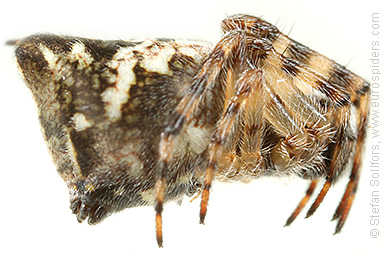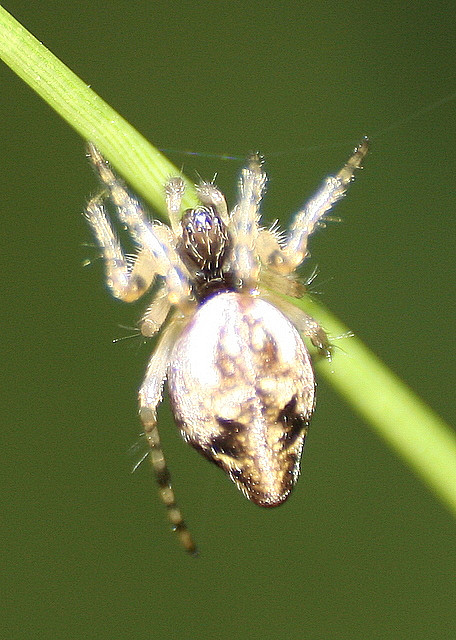Classification
| Domain: | Eukarya |
| Kingdom: | Animalia |
| Phylum: | Arthropoda |
| Class: | Arachnida |
| Order: | Araneae |
| Family: | Araneidae |
| Genus: | Cyclosa |
| Species: | Cyclosa conica |
Descriptions of Classification:
There is careful thought that goes into naming a human being and
odds are your name was chosen very carefully from a long list. The
name that won out among the rest had some sort of sentimental value
to your parents, whether it was based off of someone else in your
family, or had a special meaning. Just like naming a human is a
daunting process, there are specific and meticulous reasons and
thoughts that go into your classifying and naming an organism. This
section will aim to clarify the reasoning behind
Cyclosa's
classification among the tree of life and how it got its name!
Eukarya
The possession of a true
nucleus and membrane-bound organelles places this spider among this
domain of life.
Animalia
Cyclosa conica is
considered Animalia due to its multicellularity, heterotrophic
lifestyle, motility at some stage
in development, and lack of a structural cell wall. Let's take a
moment and break down some of the complex ideas behind what makes an
organism a part of the Animalia Kingdom.
With
multicellularity comes many benefits and drawbacks. Having better
nutrition, a larger nutrient reserve, a protected internal
environment, and the possibility for separation of functions seems
like an evolutionary no-brainer right? Wrong! The surface
area-to-volume ratio creates major constraints on this cellular
arrangement! Remember, there still has to be a way for the nutrients
this organism acquires to get to the cells and the wastes that need
removal to exit the body. Next, comes the concept of a heterotrophic
lifestyle. This means that Animalia members eat other organisms to
gain the energy and nutrients they need. There is a ton of
adaptations among phyla to accommodate this lifestyle strategy.
Motility is the ability to move. Whether, this is accomplished in an
organism's adult stage for functions such as
predation, or in earlier stages of development, this is a
key aspect of what it means to be an animal. Cell walls are like
straitjackets of support that don't allow for much movement and
flexibility. Animals however, are free of this structural component
so a high range of movement and flexibility becomes possible.
Arthropoda
This organism is an arthropod because of its chitinous exoskeleton,
ecdyis molting process, segmented body, bilateral symmetry, paired
and jointed appendages, protostome development, and triploblastic
body plan. We understand that this is a mouthful, so let us break it
down into a simpler understanding.
Chitin is a
polymer of glucose, or a long string of sugar. This allows for the
arthropods, including the
Cyclosa conica, to have a lightweight, flexible, and
water-resistant exoskeleton. This exoskeleton is an external
skeleton that allows for support and muscle attachment. We like to
think of an exoskeleton as similar to the armor of the infamous
superhero
Iron Man! Ecdysis is a molting
process, where this "armor" is shed to allow the organism to grow.
Segmented bodies are really advantageous and have been considered a
major reason for the success surrounding Arthropods. Segmentation
allows for separation of functions, and lots of
movement. What does it mean to have
bilateral symmetry? This translates to the idea that the
Cyclosa can be divided
along one plane of symmetry to have two equal parts! The jointed
appendages are basically a positive an attribute due to the range of
motion they provide.
Protostome development refers to the way an organism develops as an
embryo. Being a
protostome means that your mouth forms before the anus.
Having a triploblastic body plan refers to the tissues present
in the embryo. Triploblasts have three tissues the ectoderm,
endoderm, and mesoderm. The mesoderm is located is unique to the
triploblastic species and develops into the bones, muscles, and
circulatory system.
Arachnida
Synapomorphies that link
this spider to this class are a terrestrial habitat, book lungs, and
six pairs of appendages including four pairs of legs, a pair of
pedipalps, and a pair of chelicerae (Campbell et al. 2008).
Book lungs
look like folded pages of a book and are composed of air pockets and
compartments that house fluids. Pedipalps, are incredibly important
structures for reproduction, sensing
the environment, and feeding purposes that are found in the mouth
region of Arachnids. The chelicerae look like fangs and are
oftentimes used as structures to attack prey.
Araneae
What classifies this
spider in this order are its lack of wings and antennae, predatory
lifestyle, and lifecycle stages that proceed from egg to spiderling
to adult (Texas A&M Agrilife Extension n.d.).
These
characteristics are more self-explanatory than the ones we’ve
previously seen, but if you are interested in learning more about
the Cyclosa’s predatory
lifestyle check out the interactions
page.
Araneidae
This spider is classified in this class because of their eight eyes,
their tendency to capture prey in webs, their ability to spin
orb webs, and the consumption of males after reproduction
(University of Illinois n.d.). An example of an organism of this
class that lives in my town, La Crosse, WI, is the
Gasteracantha cacriformis.
Cyclosa
The shared characteristics among
Cyclosa spiders include a
narrow head, PME's that are close together, and a unique groove that
is shaped like the letter U (Keswani 1963). These are also
considered trash line orb weavers due to the composition of their
webs (BugGuide 2012).
PME’s are
extremely complex and can be simply be understood as a type of
enzyme. This means that they catalyze reactions that occur in
Cyclosa bodies and make
life possible for these organisms. Trash line orb weaver is
considered the common name for our organism! This name comes from
the tendency of the spider to include bits of
prey and debris into its orb web
(Blackledge et al. 2005).
Cyclosa conica:
There isn’t much that separates the
Cyclosa conica from the
rest of the genus. They have one or two large hairs called setae
that are placed on the base of the front legs of the organism and a
cone-shaped body (BugGuide 2012).
Etymology: Origin of the name
Cyclosa conica:
Cyclosa:
circle or ring
conica:
Cone-shaped
These words were carefully chosen with special meanings to identify
this spider. The circle portion pertains to the way the spider
generates the web in an orb shape, whereas the word
conica refers to its body
shape (Online Etymology Dictionary n.d.).
.jpg)
This is a phylogeny that represents the class
Arachnida. As we can
see, this class includes many orders of organisms, including Araneae
which is where our beloved Cyclosa can be found. This is a more
specific classification of the Arthropod phylum. Many Arthropods
include insects, crustaceans, spiders, and milipedes. This tree is
aiming to focus in on only the spider aspect of this classificaiton
and break down those relationships. We can see that the Araneae
where our Cyclosa can be found is closely related to tailless
whipscorpions, whiptailed scorpions, and the Schizomida. In summary,
we can conclude that spiders are closely related to scropions.
This phylogeny is in place to break down the
family Araneidae into its subsequent genuses. There would be a
plethora of genuses present, so in order to maintain cleanliness and
organization among the tree the Cyclosa's were grouped into
a Coxal Hook Clade. The Coxal Hook Clade containing the Cyclosa
forms has a sister taxa, the Dolophones. This tree is
basically showing where the Cyclosa resides within the
evolutionary relatedness of orb-weaving spiders.
<<Home
Referencess
Habitat>>>



.jpg)